The PIEEG-16, a shield for RaspberryPi designed to measure 16 channels of various biosignals, including EEG (electroencephalography), EMG (electromyography), and ECG (electrocardiography) without any data transfer over the network (Wi-Fi, Bluetooth) , that allow make signal processing processing and feature extraction directly on the Raspberry in real-time.
Affordable Multichannel Measurement: The PIEEG-16 offers a budget-friendly solution for capturing 16 channels of EEG data, making it accessible to researchers, students, and hobbyists alike.
Open-Source Software: Accompanied by Python-based open-source software, the device enables users to process and analyze data with flexibility and transparency.
Near Real-Time Performance: The system boasts almost real-time capabilities, allowing for rapid adjustments to the ADS1299 chip registers and easy customization of the provided SDK to meet specific user requirements.
Satisfactory Signal Quality: Despite its affordability, the PIEEG-16 demonstrates a commendable noise level and accuracy in artifact detection, ensuring reliable data collection.
Validated Alpha Rhythm Detection: The device has been tested for the ability to detect alpha rhythms, a critical brain wave pattern in neuroscience research.
This innovative tool opens up new possibilities for neuroscience research and brain-computer interface experiments. By combining the power of RaspberryPi with specialized biosignal measurement capabilities, the PIEEG-16 represents a significant step forward in democratizing neuroscience research and exploration.
As a helmet/cap, we used the one from the PiEEG (website available in the PiEEG shop). Electrodes were installed according to the international electrode placement system “10-20”.
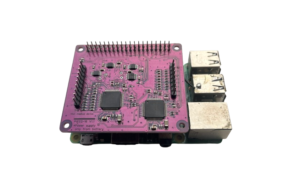
General view
During the test, the device was not connected to the electrical source, this was done both for safety and to avoid network interference.
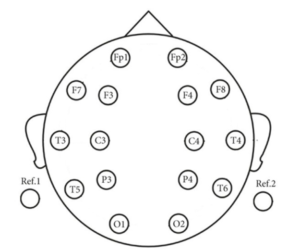
Locations of the electrodes
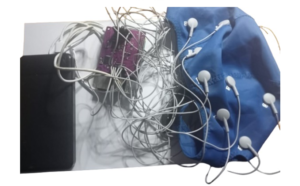
Connections electrodes and PiEEG device
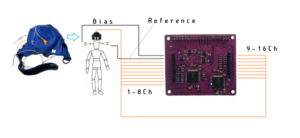
Schematic connection for PiEEG
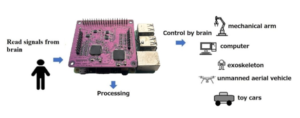
PiEEG example of an application
Test for Chewing and blinking Artifacts for PiEEG-16
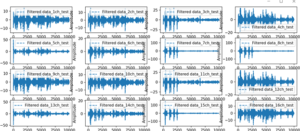
Artifact test. The process of measuring chewing and blinking artifacts using dry electrodes (Fz). Chewing occurred in the following sequence: 4 times, 3 times, 2, and 1 time, and the same for the blinking process. The y-axis is the processed EEG signal after passing filter bands of 1-40 Hz in microvolts and with 250 samples per second (dataset – https://github.com/pieeg-club/PiEEG-16/blob/main/Dataset/2.Chewing_Blinking.xlsx )
Alpha wave (α-wave) brain signal from 7 to 15 Hz with an approximate amplitude selection of 35-65 μV can be used to test the EEG capture system. Generally, alpha waves can be detected in awake people with closed eyes during the relaxation process. We used 16 electrodes for the test. Each time we measured the EEG signal – 5 seconds for closed eyes and 5 seconds for open eyes. As expected, we found an increase in the amplitude of the EEG signals in the frequency band from 9 to 13 Hz. Also, as expected, we found a weakening of the alpha activity for the time when the eyes were open.
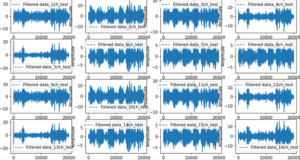
Alpha test. The process of recording an EEG signal from an electrode (Fz) with eyes open and closed. The y-axis is the processed EEG signal after passing filter bands of 8-12Hz in microvolts and with 250 samples per second (dataset – https://github.com/pieeg-club/PiEEG-16/blob/main/Dataset/3.Alpha_test.xlsx)
Alpha test with wavelet (Dry Electrodes, no Gel, 5-sec eyes closed, 5-sec eyes closed and again)
Alpha test with wavelet (Dry Electrodes, no Gel, 5-sec eyes closed, 5-sec eyes closed and again) with Dataset
A promising further direction for this research is its practical use as a brain-computer interface (BCI). Since this work provides high-quality data transfer between the ADC and the processor without time delays in the process, the proposed device can be used in real-time conditions. BCI is used in several areas today, not least helping people with disabilities. However the corresponding devices today require the use of neural networks to establish correlations in the signals and therefore must use a large amount of data to train these networks. However, even for this study, it is better to use compact, inexpensive devices that can operate autonomously for long periods. Raspberry PI is very popular, so we hope that this device will interest many researchers, with which we hope to collect a large data set.
GitHub
Would you like to receive news?